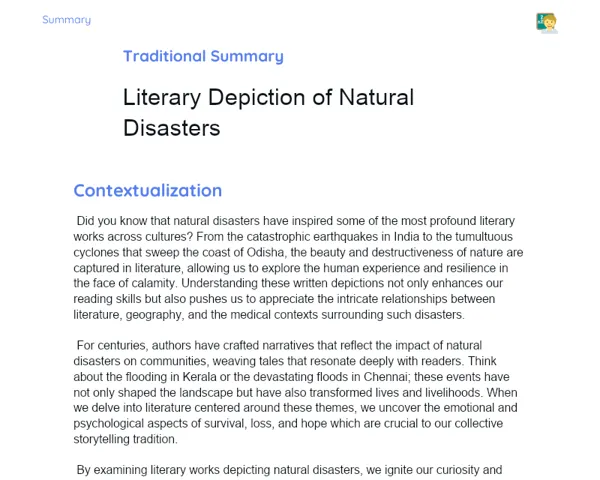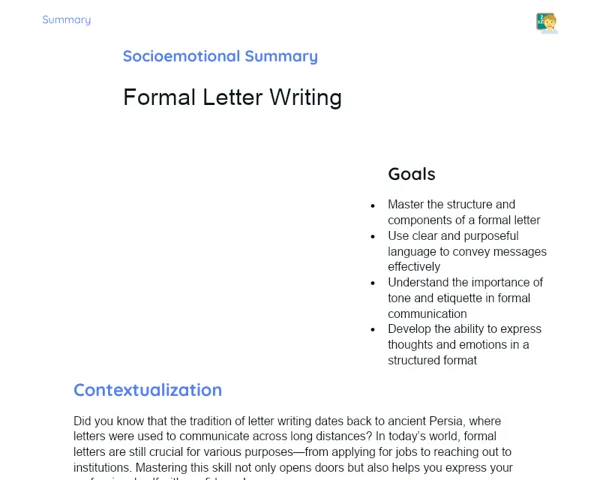Traditional Summary | Identifying Characters in a Story
Contextualization
Did you know that every story is like a vibrant festival, filled with colorful characters who bring it to life? 🎉 From brave heroes to clever villains, characters are the heart and soul of any narrative. They help us connect with the plot and evoke emotions that resonate with our own experiences. Think about your favorite stories—whether it's a classic tale like 'Aladdin' or a modern adventure like 'Harry Potter', the characters are what make these tales unforgettable!
In our everyday lives, we meet different types of characters too! Just like in the stories we read, we encounter friends who support us, teachers who guide us, and sometimes even challenges that test our strength. Understanding the roles and characteristics of these characters can help us better relate to those around us, making our social interactions much more meaningful. ✨
As we learn to identify characters in stories, we are also learning to identify parts of ourselves. Each character teaches us a lesson, and as we delve into their unique traits and roles, we gain insights into friendships, courage, and the importance of teamwork. So, gear up for an exciting journey into the world of characters, where every turn of the page reveals a new adventure waiting to be explored! 📚✨
To Remember!
Main Characters
Main characters are the stars of any story! They are the ones whose journey we follow and whose experiences shape the narrative. For example, in the tale of 'Ramayana', Lord Rama is the main character whose values of duty, loyalty, and courage exemplify what it means to be a true hero. Main characters can be heroes who save the day or heroines who overcome great challenges, but they all play a crucial role in making the story engaging and relatable. Understanding their motivations, strengths, and weaknesses allows us to connect deeply with the story and see reflections of our own lives in their adventures.
-
Main characters drive the plot forward - Without them, there is no story. They face conflicts and challenges, which keeps readers engaged.
-
They often experience growth - Main characters typically undergo significant changes throughout the story, teaching us valuable lessons about resilience and personal development.
-
They connect us to the story - By identifying with main characters, we can reflect on our own lives and relate to their experiences, making the story more impactful.
Supporting Characters
Supporting characters are like the vibrant colors in a painting; they enhance the main characters’ journey by adding depth and richness to the story. These characters can be friends, family members, or even mentors who help the main characters along their path. For example, in 'Harry Potter', characters like Hermione and Ron are essential to Harry's adventures, providing support and sometimes even comic relief. Supporting characters help to illustrate the themes of friendship, loyalty, and teamwork, making every story a comprehensive tapestry of relationships.
-
They provide support to the main characters - Supporting characters often play crucial roles in helping the protagonist achieve their goals, showcasing the importance of teamwork.
-
They add depth to the story - By having diverse personalities and backgrounds, supporting characters make the narrative richer and more relatable to different audiences.
-
They can also represent conflicts - Some supporting characters may serve as antagonists or obstacles, highlighting the challenges that main characters must overcome.
Antagonists
Every great story needs a bit of drama, and that's where the antagonists come in! These are the characters who oppose the main characters and create conflict in the story. Antagonists can be villains, obstacles, or even internal struggles within the main character himself. In 'Dangal', the wrestlers face their own fears and societal expectations, while competing against formidable opponents. Understanding antagonists is vital because they often drive the plot and challenge our heroes, illustrating themes of courage, determination, and the struggle between good and evil.
-
They create conflict - Without antagonists, there would be no challenges for the main characters to overcome, making the story less exciting.
-
They help to highlight the virtues of the protagonists - By opposing the heroes, antagonists reveal the main characters' strengths and values, allowing readers to appreciate their journeys.
-
Understanding antagonists can offer insights - By analyzing their motivations and backgrounds, readers can learn about the complexities of human nature and moral dilemmas.
Key Terms
-
Main Characters: The central figures in a story whose journey we follow, often experiencing growth and transformation.
-
Supporting Characters: Characters who assist the main characters, adding depth and dimension to the narrative.
-
Antagonists: Characters that oppose the main characters, creating conflict and driving the plot forward.
Important Conclusions
In our lesson on identifying characters in a story, we explored how each character plays a unique role that shapes the narrative. Main characters, like Lord Rama in 'Ramayana' or Harry Potter in his magical adventures, serve as the heart of the story, leading us through their journeys, growth, and the valuable lessons they teach us. Supporting characters add richness to the plot, illustrating themes of friendship and teamwork, while antagonists bring excitement and challenges, emphasizing the virtues of the protagonists. Understanding these characters not only enhances our reading experience but also connects us to our own lives and the diverse personalities we encounter daily. 🌈✨
So remember, stories are not just for entertainment; they are a powerful tool for understanding ourselves and the world around us. By identifying with the characters, we gain insights into our own friendships, struggles, and triumphs. Now, let’s keep exploring the magical world of stories and the characters within them! 📖💖
Study Tips
-
Revisit your favorite stories and identify the main, supporting, and antagonist characters – think about their roles and how they contribute to the plot!
-
Create character maps for stories you read – draw connections between characters, their traits, and the lessons they teach.
-
Discuss stories with friends or family, sharing your insights about each character. This will deepen your understanding and make reading even more enjoyable!



